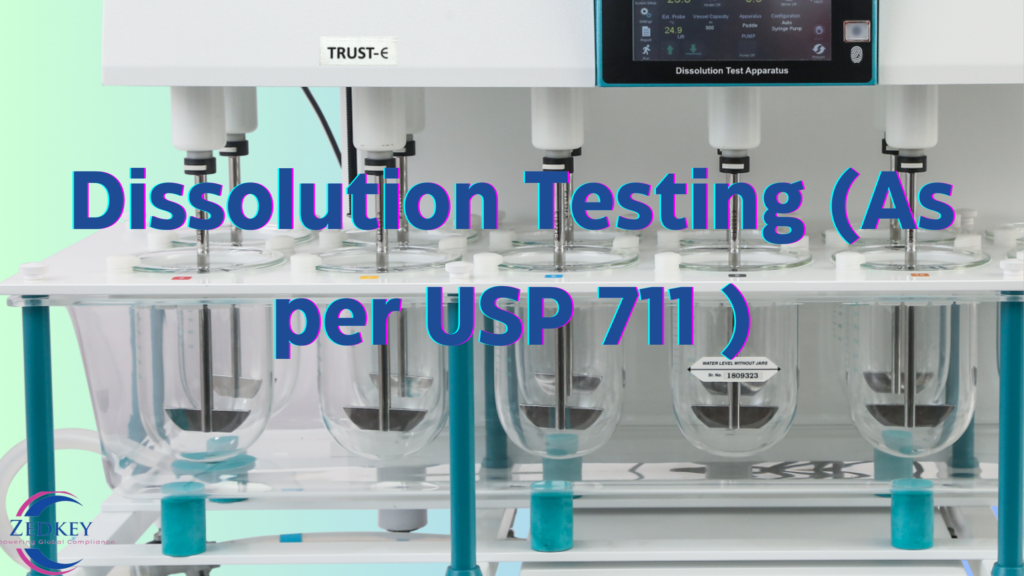
What is Dissolution Testing?
Dissolution testing measures how quickly and completely a drug dissolves in a particular solvent. The United States Pharmacopeia (USP) standard for dissolution testing, known as USP <711>, provides guidelines to ensure consistency and quality in drug release. This test is essential in evaluating how a drug will perform in the body and confirming that the dosage forms (tablets, capsules) release their active ingredients at the correct rate.
Why is Dissolution Testing Necessary?
When a patient takes a medication, the active ingredient (the part that provides therapeutic effects) must dissolve in the body before it can be absorbed into the bloodstream. Dissolution testing simulates this process in a controlled lab environment. This helps to determine:
- How quickly the drug dissolves in the body.
- Whether the drug will be effective by providing the right dose over time.
- If the drug meets quality standards for consistency across different batches.
Dissolution testing is especially vital for extended-release and delayed-release formulations, where drug release must happen gradually or only after reaching a certain part of the digestive tract.
Types of Dissolution Apparatus
The USP <711> dissolution test specifies several apparatus types, each suited to different dosage forms:
- Apparatus 1 (Basket Apparatus): Commonly used for tablets and capsules. The dosage form is placed in a basket that rotates in a dissolution medium to simulate the conditions in the stomach or intestines.
- Apparatus 2 (Paddle Apparatus): Widely used for tablets. A paddle stirs the dissolution medium at a specified speed, with the tablet placed at the bottom of the vessel.
- Apparatus 3 (Reciprocating Cylinder): Ideal for testing both immediate and extended-release formulations, especially when simulating conditions that involve variable pH levels.
- Apparatus 4 (Flow-Through Cell): Useful for drugs with low solubility or dosage forms that require continuous fluid flow, such as implants.
Each apparatus has unique features to match the needs of different drug forms, allowing accurate assessment of drug release.
Procedure: Step-by-Step Dissolution Testing
The process for dissolution testing under USP <711> involves the following steps:
- Prepare the Dissolution Medium
The dissolution medium, which can range from acidic solutions (like 0.1 N hydrochloric acid) to buffers, is selected to simulate the digestive environment. It is also deaerated (air removed) to avoid bubbles that might affect results. - Set Up the Apparatus
Fill the vessel with the dissolution medium and equilibrate it to a constant temperature of 37 ± 0.5°C. Then, add the dosage unit to the medium, ensuring it’s placed in the designated apparatus (e.g., inside the rotating basket or beneath the paddle). - Sample Collection
Samples are withdrawn at pre-defined time points (such as 5, 10, 15, and 30 minutes) to track how much of the active ingredient has dissolved over time. These samples are filtered to remove any undissolved particles. - Measure and Analyze
The concentration of dissolved active ingredient is determined using analytical methods like UV spectrophotometry or High-Performance Liquid Chromatography (HPLC). This allows for precise measurement and comparison against target dissolution criteria. - Repeat as Necessary
Depending on the type of drug, testing may be conducted in multiple stages (such as L1, L2, and L3) for an added layer of verification. This is especially common for controlled-release drugs where consistent dosing over time is essential.
Interpretation of Results: Understanding USP <711> Dissolution Standards
After the testing is complete, the results are interpreted based on set criteria, ensuring each batch of medication meets USP <711> standards. Here’s how the dissolution results are evaluated for different types of dosage forms:
Immediate-Release Dosage Form
| Stage | Number of Units Tested | Acceptance Criteria |
| L1 | 6 units | Each unit must dissolve at least Q + 5% of the active ingredient. |
| L2 | 12 units (L1 + 6 more) | The average of all 12 units must meet Q, with no single unit below Q – 15%. |
| L3 | 24 units (L1 + L2 + 12 more) | The average meets Q. No unit below Q – 15%, and no more than 2 units below Q – 25%. |
Extended-Release Dosage Form
| Stage | Number of Units Tested | Acceptance Criteria |
| L1 | 6 units | No unit should fall outside specified ranges; all units should be at least the labeled amount at final time. |
| L2 | 12 units (L1 + 6 more) | Average meets the label; no more than 10% deviation from labeled content for any unit. |
| L3 | 24 units (L1 + L2 + 12 more) | Average meets label; no more than 10% deviation for most units, with none deviating more than 20%. |
Delayed-Release Dosage Form
Delayed-release forms are tested in two stages, reflecting the drug’s journey through the digestive tract.
- Acid Stage: The drug is tested in an acidic medium, generally with minimal dissolution expected. This confirms that the drug remains stable in acidic conditions.
- Buffer Stage: After the acid stage, a buffer (usually at pH 6.8) is added to simulate the intestine. Dissolution in this stage confirms the release of the drug when it reaches the intended area.
| Stage | Number of Units Tested | Acceptance Criteria |
| B1 | 6 units | Each unit must be Q + 5% dissolved. |
| B2 | 12 units (B1 + 6 more) | Average of all 12 units meets Q, no unit below Q – 15%. |
| B3 | 24 units (B1 + B2 + 12 more) | Average meets Q; no more than 2 units below Q – 15%, and no unit below Q – 25%. |

